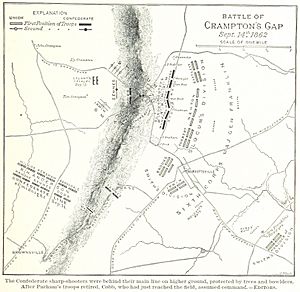Battle of Crampton's Gap facts for kids
Quick facts for kids Battle of Crampton's GapBattle of Burkittsville |
|||||||
|---|---|---|---|---|---|---|---|
| Part of the American Civil War | |||||||
|
|||||||
| Belligerents | |||||||
| Commanders and leaders | |||||||
| Strength | |||||||
| 12,800 | 2,100 | ||||||
| Casualties and losses | |||||||
| 533 total (115 killed, 416 wounded, 2 missing) |
887 total (130 killed, 759 wounded) |
||||||
The Battle of Crampton's Gap was a fight during the American Civil War. It happened on September 14, 1862, in Western Maryland. This battle was part of the larger Battle of South Mountain.
Union forces, led by William B. Franklin, fought against Confederate soldiers. The Confederates were commanded by Howell Cobb. The battle took place at Crampton's Gap, a mountain pass.
Franklin's soldiers attacked a small Confederate group. These Confederates were protecting the rear of another Confederate general, Lafayette McLaws. McLaws was busy attacking Harpers Ferry. Even though they were outnumbered, the Confederates held their ground for hours.
The Union army eventually broke through the Confederate lines. They pushed through the gap into Pleasant Valley. This was a victory for the Union on the battlefield. However, the Confederates succeeded in slowing down the Union advance. This delay helped protect McLaws' army.
Contents
Why the Battle Happened
On September 13, 1862, Union General George B. McClellan found a lost paper. It was Robert E. Lee's secret plan, called Special Order No. 191. This order showed that Lee had split his army. Part of it was sent to capture Harpers Ferry.
General McLaws was leading the attack on Harpers Ferry. He needed to protect his army from behind. So, he placed a small group of soldiers at Crampton's Gap. This gap was important because it led to McLaws' position.
The Confederate force at Crampton's Gap was small. It included soldiers under General William Mahone and General Howell Cobb. There was also some artillery and cavalry. General Lee knew this spot was vital. He ordered General Cobb to "hold the gap if it cost the life of every man."
General McClellan ordered Union General Franklin to attack Crampton's Gap. Franklin and his VI Corps were told to march from Buckeystown to Burkittsville. Their goal was to break through the gap and attack McLaws from behind. But Franklin's attack was delayed by almost 11 hours.
The Battle Unfolds
The small Confederate force used the mountain to their advantage. Some soldiers were at the bottom of the mountain. The artillery was halfway up. General Cobb's main group was dug in at the very top. They watched as Franklin's large Union army marched towards them.
Around noon, the Union soldiers reached Burkittsville. The Confederate artillery started firing. Franklin organized his troops into three columns. At 3 p.m., after a long delay, the Union attack finally began.
The Union advance was slow but steady. Their artillery supported them. The Union army had many more soldiers. They quickly overwhelmed the Confederates at the base and on the slopes of the mountain. The Confederates had to retreat.
General Cobb tried to rally his men at the top of the mountain. But a charge by the First New Jersey Brigade was too strong. The Union VI Corps reached the summit. They quickly drove the Confederates from their positions. This part of the fight lasted only about fifteen minutes. Many Confederates were hurt or captured.
After the Confederate line broke, their soldiers scattered. They ran into Pleasant Valley. They could no longer fight. But their stand had lasted three hours. This delay, combined with Franklin's slow start, meant it was after 6:00 p.m. when the Union army regrouped. It was too late to attack McLaws on Maryland Heights that day. The next day, Harpers Ferry surrendered to the Confederates.
What Happened Next
The Union VI Corps had 533 casualties. This included 115 killed and 416 wounded. The Confederate forces suffered 887 casualties. This included 130 killed and 759 wounded.
From a tactical view, the Union won. They successfully drove the Confederates from the gap. This was the first time any part of Lee's army had been forced to retreat in this way.
However, from a strategic view, the Confederates succeeded. They held off the Union army for three hours. They were outnumbered almost six to one. This delay was enough to keep McLaws safe. It also allowed Harpers Ferry to be captured the next morning.
Even more importantly, General Franklin did not attack McLaws after taking Crampton's Gap. This allowed another Confederate general, Stonewall Jackson, to rejoin Lee's main army. This set the stage for the Battle of Antietam three days later. Antietam became the bloodiest single day in American history. After the Union's small victory at Antietam, President Abraham Lincoln announced the Emancipation Proclamation.
Preserving the Battlefield
The area where the battle happened is now a historic district. It is listed on the National Register of Historic Places. The Crampton's Gap Historic District was created on January 12, 2011. It includes the mountain around Crampton's Gap and the town of Burkittsville.
Images for kids
-
Crampton's Gap looking from the south side (Gathland State Park) to the north.



